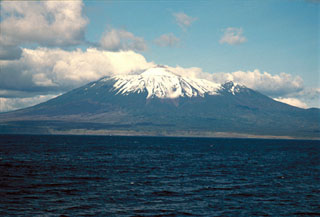Report on Chachadake [Tiatia] (Japan - administered by Russia) — November 1988
Scientific Event Alert Network Bulletin, vol. 13, no. 11 (November 1988)
Managing Editor: Lindsay McClelland.
Chachadake [Tiatia] (Japan - administered by Russia) Fumarolic activity
Please cite this report as:
Global Volcanism Program, 1988. Report on Chachadake [Tiatia] (Japan - administered by Russia) (McClelland, L., ed.). Scientific Event Alert Network Bulletin, 13:11. Smithsonian Institution. https://doi.org/10.5479/si.GVP.SEAN198811-290030
Chachadake [Tiatia]
Japan - administered by Russia
44.353°N, 146.252°E; summit elev. 1822 m
All times are local (unless otherwise noted)
Fumarolic activity in the summit crater remained at the same level. Steaming ground was observed in many parts of the crater, but well-formed fumaroles were not evident. The intensity of steam release increases when atmospheric pressure drops and after precipitation. Tiatia's last reported activity ejected a 1-1.5-km-high white steam column in February 1982.
Geological Summary. Chachadake, also known as Tiatia, consists of a beautifully symmetrical cone that rises above the broad rim of an erosionally furrowed, 2.1 x 2.4 km wide caldera. The edifice occupies the NE tip of Kunashir Island and morphologically resembles Mount Vesuvius. The pristine-looking conical central cone, mostly formed by basaltic to basaltic-andesite strombolian eruptions, rises 400 m above the floor of the caldera and contains a 400 x 250 m wide crater with two explosion vents separated by a linear septum. Fresh lava flows cover much of the SW caldera floor and have overflowed the rim, extending to the foot of the older somma, which formed during the late Pleistocene or early Holocene. A lava flow from a flank cone on the northern caldera rim reached the Sea of Okhotsk. A major explosive eruption in 1973 followed an initial historical eruption in 1812.
Information Contacts: G. Steinberg, Yuzhno-Sakhalinsk.

